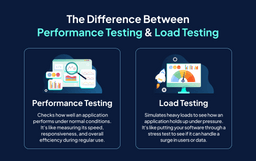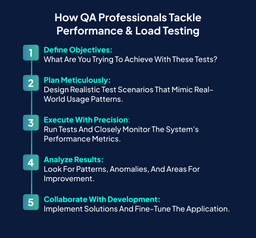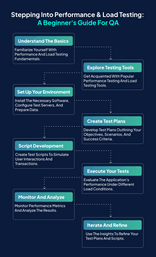Welcome back, data enthusiasts!
Did you know that in today’s fast-paced world, the revenue in the Business Intelligence Software market is projected to reach a whopping US$27.36 billion in 2024?
That’s why it’s critical to ensure software runs smoothly under pressure when building it.
That’s where performance tests and load tests come into play!
Welcome to our guide, which is courtesy of Syntax Technologies.
We’re here to make this journey through testing a breeze, giving you the lowdown on why it matters, how it works, and the best ways to do it.
That said, enrolling in a QA Automation course can significantly help you pursue a fruitful career in QA. It can also increase your chances of getting a highly-paid job in a competitive market!
So, let’s dive in and uncover the secrets to creating software that not only works but works like a charm, even when the going gets tough!
With our guide, you can take your software to the next level.
Exploring the Nuances: Performance Testing vs. Load Testing
So, you might wonder: what’s the difference between performance testing and load testing? Aren’t they essentially the same thing?
Well, not quite! Let’s break it down.
Performance testing is like spinning your software on a quiet Sunday drive. It’s all about checking how well your application performs under normal, everyday conditions.
Think of it as measuring its speed, responsiveness, and overall efficiency when there’s no rush hour traffic.
On the other hand, a load test is more like putting your software through a stress test during rush hour on a busy freeway.
It’s about simulating heavy loads and seeing how your application holds up under pressure.
Can it handle the influx of users, transactions, or data without breaking a sweat? Load testing helps answer that question.
In a nutshell, performance testing evaluates the system’s behavior under typical conditions, while load testing pushes the system’s performance to its limits to see how it performs under heavy loads.
Both are essential pieces of the testing puzzle, each offering valuable insights into the resilience and reliability of your software.
So, the next time you’re testing your application, remember: it’s not just about how it performs in ideal conditions but also how it handles when the going gets tough.
Navigating Performance and Load Testing: A QA Perspective
Alright, let’s talk about how we, the Quality Assurance (QA) folks, tackle performance and load testing.
First off, we start by defining clear objectives.
What exactly are we trying to achieve with these tests? Are we aiming to identify bottlenecks, measure response times, or ensure scalability?
By setting specific goals, we can tailor our testing approach accordingly.
Next, we roll up our sleeves and get down to business with some meticulous planning. This involves designing realistic test scenarios that mimic real-world usage patterns.
We consider factors like user behavior, system configurations, and expected loads to create test scripts that accurately reflect the application’s environment.
Then comes the fun part: execution.
We run our tests with precision, closely monitoring the system’s performance metrics and collecting data along the way. This is where we put our scripts to the test, unleashing varying levels of traffic to gauge how the system responds under different loads.
But our job continues beyond there. Oh no, we’re just getting started!
Once the tests are complete, we roll up our sleeves again to analyze the results. We pore over the data, looking for patterns, anomalies, and areas for improvement. This is where our detective skills come into play as we uncover hidden issues and pinpoint areas that need attention.
Finally, armed with our findings, we collaborate with the development team to implement solutions and fine-tune the application for optimal performance testing processes. It’s a collaborative effort, with QA acting as the watchdogs for quality every step of the way.
So, there you have it! That’s how we QA folks handle performance and load testing, ensuring that software meets and exceeds speed, reliability, and scalability expectations.
How to Use Performance Testing Tools and Load Testing Tools as a QA
Let’s dive into how we QA folks leverage performance testing and load testing tools to ensure software excellence:
- Selecting the Right Tools: The first step is to choose the appropriate QA tools for the job. There are many options out there, ranging from open-source favorites like JMeter and Gatling to commercial solutions like LoadRunner and BlazeMeter. We carefully evaluate each tool based on features, scalability, ease of use, and compatibility with our technology stack.
- Tool Setup and Configuration: Once we’ve chosen our weapons, it’s time to set them up and configure them to suit our testing needs. This involves installing the tools, configuring test environments, and fine-tuning settings such as concurrency levels, ramp-up periods, and data parameters.
- Script Development: With our tools primed and ready, we embark on the journey of script development. This is where we craft test scenarios that simulate real-world user interactions, transactions, and workflows. Whether it’s recording user sessions, writing code scripts, or using visual editors, we ensure our scripts accurately reflect the application’s behavior under different conditions.
- Execution and Monitoring: With our scripts in hand, we kick off the tests and closely monitor the system’s performance metrics in real time. We closely monitor key indicators like response times, throughput, error rates, and resource utilization. We use dashboards and reports provided by the testing tools to track progress and identify any deviations from expected behavior.
- Results Analysis and Reporting: Once the tests are complete, we roll up our sleeves and dive into the data. We analyze the results with a fine-tooth comb, looking for trends, patterns, and anomalies that could indicate performance bottlenecks or areas for improvement. We compile our findings into comprehensive reports with insights, recommendations, and actionable next steps.
- Continuous Iteration and Improvement: Last but not least, we embrace a culture of constant improvement. We use the insights gained from our testing efforts to iterate on our scripts, refine our testing strategies, and drive enhancements to the application’s performance and scalability over time.
By harnessing the power of performance testing and load testing tools, we QA folks play a pivotal role in ensuring that software meets and exceeds performance expectations, delivering a seamless user experience every step of the way.
Stepping into Performance and Load Testing: A Beginner’s Guide for QA
Embarking on your journey as a QA tester in performance and load testing can seem daunting, but fear not!
Here’s a step-by-step guide, accompanied by real-life examples, to help you navigate this exciting terrain:
Understanding the Basics
Start by familiarizing yourself with performance and load testing fundamentals. For example, imagine you’re testing an e-commerce website. Your goal might be to ensure that the website can handle a surge in traffic during the holiday season without crashing or slowing down.
Exploring Testing Tools
Get acquainted with popular performance testing and load testing tools. Take, for instance, JMeter. You might use JMeter to simulate hundreds or thousands of concurrent users browsing your e-commerce site and placing orders simultaneously, ensuring that the system can handle the load without performance degradation.
Setting Up Your Environment
Set up your testing environment by installing the necessary software, configuring test servers, and preparing test data. In our e-commerce example, this could involve setting up test servers to mimic the production environment and generating test data, such as sample products and user accounts.
Creating Test Plans
Develop test plans outlining your objectives, scenarios, and success criteria. For instance, you might create a test plan to measure the response time of the checkout process under varying loads. Your success criteria could include ensuring the checkout process is completed within a specified time frame.
Script Development
Create test scripts to simulate user interactions and transactions. Using JMeter, you could record user sessions of adding items to the shopping cart, entering payment information, and completing the checkout process. These scripts would then be executed to simulate real-world user behavior during load testing.
Executing Your Tests
Execute your tests to evaluate the e-commerce website’s performance under different load conditions. For example, you might gradually increase the number of virtual users in JMeter to simulate increasing traffic levels and observe how the system responds in terms of response time and throughput.
Monitoring and Analysis
Monitor the performance metrics generated during your tests and analyze the results. You might use JMeter’s built-in monitoring tools to track metrics like response time, throughput, and error rates in real-time. After the tests, the collected data will be analyzed to identify performance bottlenecks and areas for optimization.
Iterating and Refining
Use the insights gained from your testing efforts to refine your test plans and scripts. For instance, based on the analysis of test results, you might optimize the checkout process by optimizing database queries or caching frequently accessed data. Continuously iterate on your testing strategies to improve the overall performance and reliability of the e-commerce website.
Unveiling the Power of Stress Testing: Beyond Performance and Load Testing
Let’s dive into the dynamic world of stress testing and discover why it’s a game-changer for QA professionals:
Redefining Limits
Stress testing isn’t just about pushing boundaries; it’s about redefining them. Imagine being in charge of testing a gaming server. Stress testing allows you to unleash a barrage of simultaneous player connections, pushing the server to its absolute limits to see how it holds up under intense pressure.
Spotting the Weak Links
Stress testing isn’t for the faint-hearted; it’s for the fearless QA warriors ready to uncover hidden weaknesses. Picture stress testing a mobile banking app. By bombarding it with a deluge of transaction requests or emulating sudden spikes in user activity, you unveil potential weak links like database bottlenecks or app crashes before they wreak havoc in the real world.
Turning Risks into Opportunities
Stress testing isn’t just about identifying risks; it’s about turning them into opportunities for growth. Think about stress testing an e-commerce platform. By simulating a surge in holiday traffic or a frenzy of last-minute orders, you transform potential disasters into success stories by ensuring the platform remains resilient and responsive no matter what.
Building Resilience
Stress testing isn’t a challenge to be feared; it’s an opportunity to build resilience. Envision stress testing a cloud-based service. By subjecting it to extreme conditions like network failures or hardware malfunctions, you ensure it can weather the storm and emerge stronger, ready to serve customers without missing a beat.
Thriving on the Edge
Stress testing isn’t just about surviving; it’s about thriving on the edge. Consider stress-testing a streaming platform. By pushing it to its breaking point with a flood of simultaneous viewers, you ensure it can deliver seamless playback experiences even during peak demand, leaving users impressed and coming back for more.
In essence, stress testing isn’t just another checkbox on the QA checklist; it’s a transformative journey that empowers QA professionals to push boundaries, uncover opportunities, and build resilience in the face of adversity.
So, embrace the challenge, unleash your creativity, and let stress testing propel your QA efforts to new heights.
Elevate Your QA Journey with Syntax Technologies
Stress testing emerges as a pivotal tool in the QA arsenal, offering a pathway to uncover hidden vulnerabilities, build resilience, and ensure software excellence in the face of adversity.
By embracing stress testing alongside performance and load tests, QA professionals can elevate their testing efforts to new heights, safeguarding the success and reliability of the products they support.
Ready to embark on your stress-testing journey?
Look no further than Syntax Technologies!
Our comprehensive course equips QA professionals with the knowledge, skills, and practical insights to master stress testing and excel in their careers.
With expert-led instruction, hands-on exercises, and real-world examples, you’ll gain the confidence and expertise to navigate the complexities of stress testing easily.
Enroll now and join us at Syntax Technologies and unlock the full potential of stress testing to propel your QA career forward. Together, let’s raise the bar for software quality and innovation!




